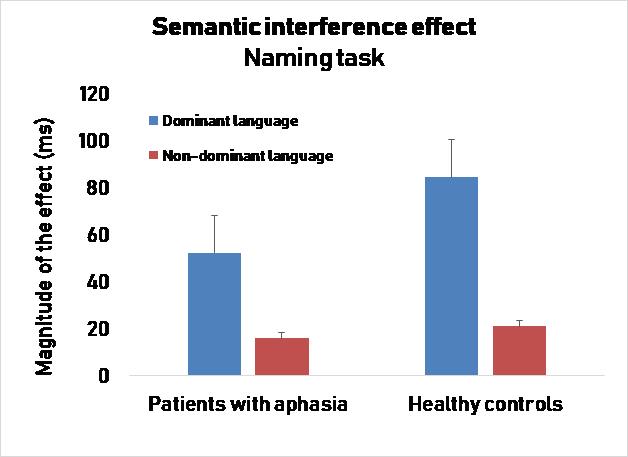Semantic and cognitive control deficits could be related in bilingual patients
Semantic and cognitive control deficits could be related in bilingual patients
Such are the findings of a study published in the journal Frontiers in Human Neuroscience by Marco Calabria, Nicholas Grunden, Mariona Serra and Albert Costa, members of the Speech Production and Bilingualism research group at the Center for Brain and Cognition, together with researchers from Hospital de la Santa Creu i Sant Pau.

Difficulty in retrieving words in a conversation is a typical type of language deficit of people who have suffered a stroke. Researchers who study language disorders (aphasia) have shown that these difficulties may affect different linguistic processes. One of them would be the inability to inhibit words that are activated simultaneously due to being semantically related to the object drawn. That is to say, if we see the image of a dog, the lexical system (our brain’s ‘dictionary’) activates all the words of similar animals. Therefore, patients with aphasia make more mistakes when selecting the correct word and so, for example, rather than saying ‘dog’ they might say ‘cat’.
A study has investigated whether these language inhibition deficits were affected in the same way in both languages in bilingual Catalan-Spanish speakers with aphasia
The aim of a study published in June in the journal Frontiers in Human Neuroscience was to investigate whether these language inhibition deficits were affected in the same way in both languages in bilingual Catalan-Spanish speakers with aphasia. Its authors are Marco Calabria, first author of the article, Nicholas Grunden, Mariona Serra and Albert Costa (deceased, December 2018), members of the Speech Production and Bilingualism research group at the Center for Brain and Cognition of the Department of Information and Communication Technologies (DTIC) at UPF, together with researchers from Hospital de la Santa Creu i Sant Pau (School of Language Pathology and Neuropsychology Service).
To investigate this issue, “we asked the study participants to name pictures under two conditions. The pictures shown were either all from the same semantic category, such as animals or fruit, or they were of different semantic categories, mixed up”, explains Calabria.
The hypothesis was that when naming pictures of the same semantic category, more time is taken because there is a higher level of interference, i.e., the system has more difficulties in inhibiting candidates that share the same characteristics, for example animals with four legs (‘cat’ and ‘dog’ compared with ‘cat’ and ‘apple’).
The first results of the study showed that patients indeed took longer and made more mistakes than those in the control group when the pictures were semantically related. Moreover, these difficulties in retrieving words increased when they performed the task in the less dominant language, although their language proficiency and age of acquisition of Spanish and Catalan were comparable. “This indicates that the processes of lexical inhibition and retrieval may be affected differently for the two languages also in highly competent patients who learned the language at an early age”, explains Calabria.
A second goal of the study was to investigate whether language deficits were also associated with deficits in cognitive control processes
The study had a second goal which was to investigate whether language deficits were also associated with deficits in cognitive control processes. In order to examine this aspect, the participants performed a task that measured their efficiency at responding to stimuli that contained inconsistent information (i.e., the direction in which an arrow pointed when presented with others pointing in the opposite direction).
In general, “the patients were slower than their healthy controls in this task and this suggests that they had difficulty in monitoring the control needed to manage conflict of inconsistent information. Finally, these cognitive control deficits correlated with the performance of the language task, but only when performed in the second language”, adds Calabria.
In conclusion, the study shows that experimental tasks are useful tools to find out which are the mechanisms that may be affected in patients with bilingual aphasia. Furthermore, the results suggest some relationship between deficits of the linguistic and non-linguistic domain. “All of this tells us that we could consider new types of language therapies that include tasks that stimulate the control of the two languages, executive aspects, attentional processes in order to maximize the benefits”, the authors suggest.

In conclusion, the study shows that experimental tasks are useful tools to find out which are the mechanisms that may be affected in patients with bilingual aphasia. Furthermore, the results suggest some relationship between deficits of the linguistic and non-linguistic domain. “All of this tells us that we could consider new types of language therapies that include tasks that stimulate the control of the two languages, executive aspects, attentional processes in order to maximize the benefits”, the authors suggest.
Reference work:
Marco Calabria, Nicholas Grunden, Mariona Serra, Carmen García Sánchez, Albert Costa (2019), “Semantic Processing in Bilingual Aphasia: Evidence of Language Dependency”, Frontiers in Human Neuroscience, 14 June, https://doi.org/10.3389/fnhum.2019.00205
